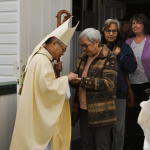For decades, the Madonna House Apostolate has been practising the Ukrainian tradition of pysanky, the “writing,” or dying of ornate eggs.
Now the tradition has taken on new significance by helping to create a sense of solidarity with people in Ukraine, says Madonna House community member Emmanuella Kim.
The centuries-old Ukrainian practice of pysanky is one of the more regal traditions regarding the ubiquitous Easter egg.

The process is deceptively simple. The contents of the eggs are removed through a hole drilled at one end of the egg, and the egg whites and yoke are collected for cooking. A small tool called a kistka then draws with melted wax, controlling where the dye will penetrate the eggshell. Understanding the order in which wax and dyes should be applied to get the desired result is challenging and rewarding.
When making pysanky eggs, it can be difficult to see the forest for the trees. During the work, the egg becomes progressively more shrouded, with wax lines and pencil scratchings covering most of its surface. It isn’t until the wax is melted off and the pencil markings scrubbed away that the colour and life of the artwork are revealed.

The whole process is a good metaphor for the Resurrection. Christ’s body was made bloody and scarred before its renewal on Easter Sunday; so too is the egg made ugly before its beauty can be unveiled with a candle flame.
The process allows for designs that are as intricate as they can be simple. Traditionally, eggs are adorned with pastoral images, including lots of plants and animals. Christian symbols are also common.
Because the dyes are applied from darkest to lightest, a standard marker of a pysanky egg can be a dark, almost-black egg punctuated with bright-coloured lines.
Madonna House community member Lisa Diniz has led many pysanky events. She told The B.C. Catholic it’s about “incarnational living,” bringing Christ’s incarnation to every aspect of life, not just in formal prayers and liturgy.
“What we are doing here is incarnating the Gospel,” she said, gesturing to the cartons of eggs from previous years. “It’s not just going to Mass for an hour – everything is a prayer.”
B.C. Catholic contributor Anna Loch said her experience with pysanky was very spiritual. “At the beginning, there was the typical social anxiety of those who didn’t know the others and the awkwardness of people when first meeting.”
She was struck by how calm the room was when they were done.
“I think doing something creative together that is hands-on can be very relaxing in and of itself,” she said, although there was also “the low-key chit chat that happened amongst the group that eased the tension and brought joy.”
Another participant wrote a small reflection for The B.C. Catholic about her experience making the eggs, writing:

“At the end, after your egg has made it through all the different beautiful, coloured dyes, you once again return the light to melt the layers of wax and reveal the design, protected and hidden under different layers.”
“We are like those eggs; simple, complex, living colourful lives yet needing to come back to the flame, the true light, to reveal to us who we truly are. What a beautiful thing to reflect on during this Lenten Season!”
The Madonna House Apostolate has practiced the pysanky tradition for much of its history, and the organization’s founder, Catherine Doherty, wrote about it in a book entitled Season of Mercy.

She describes the eggs as a bulwark against the world’s evils. “Should the custom cease,” she writes, “evil will encompass and destroy the world … Each year we do our part to keep evil from triumphing.”
“People are very moved by the symbolism of these eggs, as well as the many designs with their Christian meanings.”





